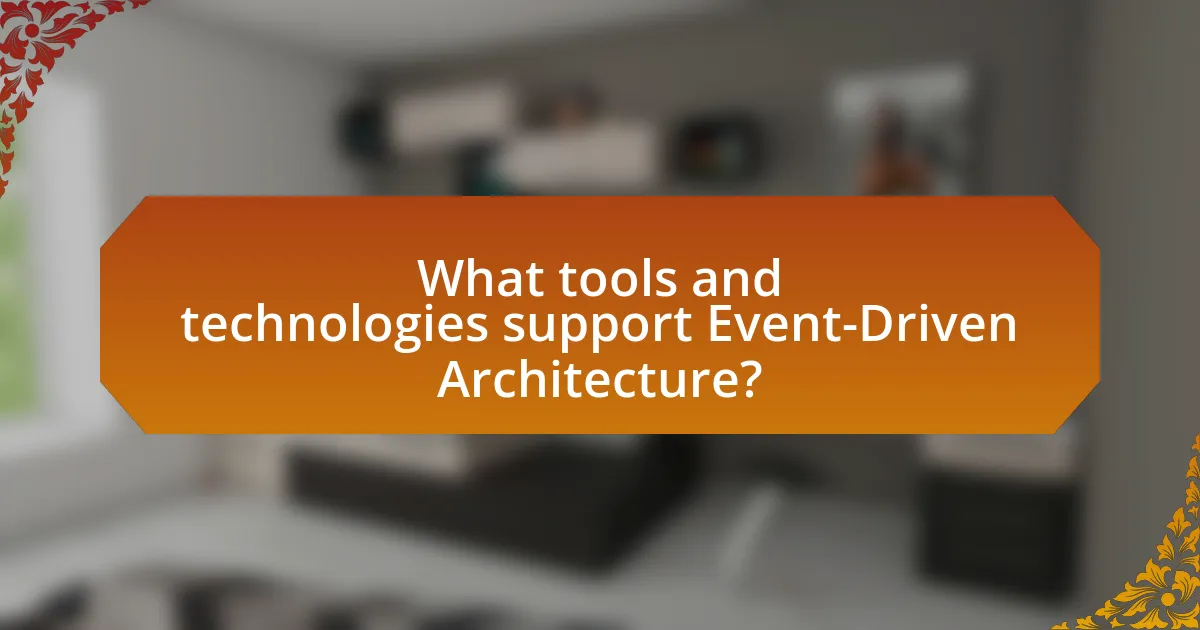Event-Driven Architecture (EDA) is a software design paradigm that facilitates the production, detection, consumption, and reaction to events, enabling real-time processing and decoupled interactions among system components. This article explores how EDA functions in software development, its key components, and the benefits it offers, such as improved scalability and responsiveness. It also discusses strategies for effective implementation, the role of microservices, and best practices for maintaining EDA, while addressing potential challenges like data consistency issues. Additionally, the article highlights tools and technologies that support EDA, including messaging systems and cloud-based platforms, and outlines key performance indicators for measuring success in EDA implementations.

What is Event-Driven Architecture?
Event-Driven Architecture (EDA) is a software design paradigm that promotes the production, detection, consumption, and reaction to events. In EDA, components of a system communicate through events, which are significant changes in state or updates, allowing for decoupled interactions and real-time processing. This architecture enhances scalability and responsiveness, as systems can react to events as they occur, rather than relying on synchronous communication. For instance, according to a study by the IEEE, EDA can significantly improve system performance and scalability by enabling asynchronous processing and reducing bottlenecks associated with traditional request-response models.
How does Event-Driven Architecture function in software development?
Event-Driven Architecture (EDA) functions in software development by enabling systems to respond to events in real-time, facilitating asynchronous communication between components. In EDA, events are generated by various sources, such as user actions or system changes, and are processed by event handlers that react to these occurrences, allowing for decoupled and scalable application design. This architecture supports high levels of concurrency and responsiveness, as components can operate independently and communicate through event streams, which enhances system performance and flexibility. For instance, according to a study by the IEEE, EDA can significantly reduce latency and improve throughput in distributed systems, demonstrating its effectiveness in modern software development.
What are the key components of Event-Driven Architecture?
The key components of Event-Driven Architecture (EDA) include event producers, event consumers, event channels, and event processing systems. Event producers generate events that represent state changes or actions, while event consumers listen for and react to these events. Event channels facilitate the communication between producers and consumers, often using message brokers or event buses to ensure reliable delivery. Event processing systems handle the logic for processing events, which can include filtering, aggregating, or transforming data based on the events received. These components work together to create a responsive and scalable architecture that can efficiently manage real-time data flows and interactions.
How do events trigger actions within this architecture?
Events trigger actions within event-driven architecture by generating notifications that prompt specific responses from the system. When an event occurs, such as a user action or a system change, it is captured by an event listener, which then processes the event and invokes the corresponding action or service. This mechanism allows for real-time processing and scalability, as multiple events can be handled concurrently without blocking the system. For instance, in a microservices environment, an event like a new order can trigger inventory updates and notifications to the shipping service simultaneously, demonstrating the architecture’s ability to respond dynamically to various inputs.
What are the primary benefits of using Event-Driven Architecture?
The primary benefits of using Event-Driven Architecture (EDA) include improved scalability, enhanced responsiveness, and increased flexibility. EDA allows systems to react to events in real-time, enabling applications to scale efficiently by processing events asynchronously. This architecture supports decoupled components, which enhances responsiveness as services can operate independently and react to events as they occur. Additionally, EDA facilitates the integration of diverse systems and technologies, allowing for greater flexibility in adapting to changing business requirements. These benefits are supported by industry practices, where organizations leveraging EDA report significant improvements in system performance and agility.
How does Event-Driven Architecture enhance scalability?
Event-Driven Architecture enhances scalability by allowing systems to process events asynchronously, enabling them to handle varying loads efficiently. This architecture decouples components, allowing them to scale independently based on demand; for instance, when an event occurs, only the relevant services are activated, reducing resource consumption. Additionally, platforms like Apache Kafka demonstrate this scalability by managing high-throughput data streams, allowing organizations to scale their applications horizontally without significant reconfiguration. This capability to dynamically allocate resources in response to real-time events is a key factor in improving overall system scalability.
What role does Event-Driven Architecture play in improving system responsiveness?
Event-Driven Architecture (EDA) significantly enhances system responsiveness by enabling real-time processing of events as they occur. This architecture allows systems to react immediately to changes or inputs, reducing latency and improving user experience. For instance, in a microservices environment, EDA facilitates asynchronous communication between services, which allows them to operate independently and respond to events without waiting for other services to complete their tasks. This leads to faster processing times and a more agile system overall. Studies have shown that organizations implementing EDA can achieve up to 50% improvement in response times compared to traditional request-driven architectures, demonstrating its effectiveness in enhancing responsiveness.

How can Event-Driven Architecture be leveraged for scalable applications?
Event-Driven Architecture (EDA) can be leveraged for scalable applications by enabling asynchronous communication between components, which allows systems to handle varying loads efficiently. This architecture supports decoupling of services, meaning that individual components can scale independently based on demand, thus optimizing resource utilization. For instance, when a high volume of events occurs, additional instances of specific services can be instantiated to process these events without affecting the overall system performance. Furthermore, EDA facilitates real-time data processing and responsiveness, as events can trigger immediate actions across distributed systems, enhancing user experience and operational efficiency. This scalability is evidenced by companies like Netflix and Amazon, which utilize EDA to manage millions of transactions and user interactions seamlessly.
What strategies can be employed to implement Event-Driven Architecture effectively?
To implement Event-Driven Architecture (EDA) effectively, organizations should adopt strategies such as defining clear event schemas, utilizing a robust messaging system, and ensuring loose coupling between services. Clear event schemas facilitate consistent communication and understanding among services, while a robust messaging system, like Apache Kafka or RabbitMQ, ensures reliable event delivery and scalability. Loose coupling allows services to evolve independently, reducing the impact of changes and enhancing system resilience. These strategies are supported by industry practices, as seen in organizations like Netflix and Amazon, which leverage EDA to achieve high scalability and responsiveness in their applications.
How do microservices fit into Event-Driven Architecture?
Microservices integrate into Event-Driven Architecture by enabling independent, loosely coupled services that communicate through events. This architecture allows microservices to react to events asynchronously, enhancing scalability and resilience. For instance, when a user places an order, an event is generated, which can trigger various microservices like inventory management and payment processing without direct dependencies. This decoupling facilitates easier updates and scaling of individual services, as evidenced by companies like Netflix and Amazon, which utilize event-driven patterns to manage high volumes of transactions efficiently.
What are the best practices for designing event schemas?
The best practices for designing event schemas include defining clear and consistent naming conventions, ensuring schema versioning, and utilizing a schema registry for management. Clear naming conventions enhance readability and understanding, while schema versioning allows for backward compatibility and smooth transitions during updates. A schema registry facilitates centralized management and validation of schemas, reducing errors and inconsistencies. These practices are supported by industry standards, such as the Confluent Schema Registry, which emphasizes the importance of schema evolution and governance in event-driven architectures.
What challenges might arise when adopting Event-Driven Architecture?
Adopting Event-Driven Architecture (EDA) can lead to several challenges, including increased complexity in system design and management. The asynchronous nature of EDA can make debugging and tracing events difficult, as events may not follow a linear path. Additionally, ensuring data consistency across distributed systems can be problematic, particularly when events are processed out of order or when failures occur. Furthermore, the reliance on messaging systems introduces potential bottlenecks and points of failure, which can impact overall system reliability. These challenges necessitate careful planning and robust monitoring solutions to effectively manage the intricacies of EDA.
How can organizations address potential data consistency issues?
Organizations can address potential data consistency issues by implementing event sourcing and using distributed transaction protocols. Event sourcing captures all changes to application state as a sequence of events, ensuring that the system can reconstruct the current state from these events, which enhances consistency. Distributed transaction protocols, such as the Two-Phase Commit, help maintain consistency across multiple services by coordinating transactions, ensuring that either all changes are committed or none are, thus preventing partial updates. These methods are supported by research indicating that event-driven architectures can significantly improve data consistency in scalable applications.
What are the common pitfalls in event management?
Common pitfalls in event management include inadequate planning, poor communication, and failure to anticipate risks. Inadequate planning often leads to overlooked details, resulting in logistical issues during the event. Poor communication among team members can create confusion and misalignment, negatively impacting execution. Additionally, failing to anticipate risks, such as technical failures or low attendance, can derail the event’s success. According to a study by the Event Marketing Institute, 70% of event planners cite lack of preparation as a primary reason for event failure, highlighting the importance of thorough planning and risk assessment in successful event management.

What tools and technologies support Event-Driven Architecture?
Event-Driven Architecture (EDA) is supported by various tools and technologies that facilitate the development and management of event-driven systems. Key technologies include Apache Kafka, a distributed streaming platform that enables real-time data feeds; RabbitMQ, a message broker that supports multiple messaging protocols; and AWS Lambda, which allows for serverless computing in response to events. Additionally, tools like Apache Pulsar and Google Cloud Pub/Sub provide robust messaging and event streaming capabilities. These technologies are widely adopted due to their ability to handle high-throughput data and support microservices architectures, making them essential for scalable applications.
Which messaging systems are commonly used in Event-Driven Architecture?
Commonly used messaging systems in Event-Driven Architecture include Apache Kafka, RabbitMQ, and Amazon SNS. Apache Kafka is a distributed streaming platform that excels in handling high-throughput data streams, making it suitable for real-time analytics and data integration. RabbitMQ is a message broker that supports multiple messaging protocols and is known for its flexibility and reliability in message delivery. Amazon SNS (Simple Notification Service) is a fully managed messaging service that enables the decoupling of microservices and facilitates the sending of notifications to distributed systems. These systems are widely adopted due to their scalability, fault tolerance, and ability to support asynchronous communication, which are essential characteristics of Event-Driven Architecture.
How do different messaging patterns affect application performance?
Different messaging patterns significantly impact application performance by influencing latency, throughput, and resource utilization. For instance, synchronous messaging patterns can lead to increased latency as the sender waits for a response before proceeding, which can bottleneck performance in high-load scenarios. In contrast, asynchronous messaging patterns allow for non-blocking communication, enabling higher throughput and better resource utilization, as senders can continue processing without waiting for responses. Research indicates that applications utilizing asynchronous messaging can achieve up to 50% better performance in terms of response times and resource efficiency compared to those relying on synchronous patterns.
What are the advantages of using cloud-based event streaming platforms?
Cloud-based event streaming platforms offer scalability, flexibility, and reduced operational overhead. These platforms can automatically scale resources based on demand, allowing organizations to handle varying workloads without manual intervention. Additionally, they provide flexibility by enabling integration with various data sources and services, facilitating real-time data processing and analytics. Furthermore, cloud-based solutions minimize the need for on-premises infrastructure, leading to lower maintenance costs and faster deployment times. According to a report by Gartner, organizations leveraging cloud-based solutions can achieve up to 30% cost savings compared to traditional on-premises systems, reinforcing the financial benefits of adopting such platforms.
How can organizations measure the success of their Event-Driven Architecture implementation?
Organizations can measure the success of their Event-Driven Architecture (EDA) implementation through key performance indicators (KPIs) such as system responsiveness, scalability, and operational efficiency. By tracking metrics like event processing time, throughput, and latency, organizations can assess how quickly and effectively their systems respond to events. Additionally, monitoring resource utilization and system uptime can provide insights into the architecture’s scalability and reliability. For instance, a study by the Cloud Native Computing Foundation found that organizations adopting EDA reported a 30% improvement in system responsiveness and a 25% increase in throughput, demonstrating tangible benefits from successful implementation.
What key performance indicators should be monitored?
Key performance indicators (KPIs) that should be monitored in event-driven architecture include latency, throughput, error rates, and resource utilization. Latency measures the time taken for an event to be processed, which is critical for user experience; throughput indicates the number of events processed in a given time frame, reflecting system capacity; error rates track the frequency of failures in event processing, essential for reliability; and resource utilization assesses how effectively system resources are being used, impacting scalability. Monitoring these KPIs ensures optimal performance and scalability of applications leveraging event-driven architecture.
How can feedback loops improve system performance over time?
Feedback loops can improve system performance over time by enabling continuous monitoring and adjustment of system parameters based on real-time data. This iterative process allows systems to adapt to changing conditions, optimize resource allocation, and enhance overall efficiency. For instance, in event-driven architectures, feedback loops facilitate the analysis of event outcomes, leading to informed decisions that refine system behavior. Research indicates that organizations implementing feedback mechanisms experience up to a 30% increase in operational efficiency, demonstrating the tangible benefits of this approach.
What are the best practices for maintaining Event-Driven Architecture?
The best practices for maintaining Event-Driven Architecture include ensuring loose coupling between services, implementing robust error handling, and monitoring event flows. Loose coupling allows services to operate independently, which enhances scalability and flexibility. Robust error handling is essential to manage failures gracefully, ensuring that events are retried or logged without disrupting the overall system. Monitoring event flows provides insights into system performance and helps identify bottlenecks or failures, enabling timely interventions. These practices are supported by industry standards, such as the use of message brokers like Apache Kafka, which facilitate reliable event delivery and processing.
How can teams ensure effective event logging and monitoring?
Teams can ensure effective event logging and monitoring by implementing structured logging practices, utilizing centralized logging systems, and establishing clear monitoring metrics. Structured logging allows for consistent data formats, making it easier to parse and analyze logs. Centralized logging systems, such as ELK Stack or Splunk, aggregate logs from various sources, enabling real-time analysis and correlation of events. Establishing clear monitoring metrics, such as error rates and response times, helps teams identify anomalies and performance issues quickly. According to a study by the DevOps Research and Assessment (DORA) team, organizations that adopt effective logging and monitoring practices experience 2.5 times more frequent code deployments and 12 times lower change failure rates, demonstrating the impact of these practices on operational efficiency.
What strategies can be used for versioning events in production?
Versioning events in production can be effectively managed through strategies such as event schema evolution, using versioned event types, and implementing backward compatibility. Event schema evolution allows for changes in the structure of events without breaking existing consumers, ensuring that new fields can be added while maintaining the integrity of older versions. Using versioned event types involves creating distinct event types for different versions, which helps in clearly distinguishing between changes and allows consumers to choose which version to process. Implementing backward compatibility ensures that new event producers can still communicate with older consumers, thus preventing disruptions in the event-driven architecture. These strategies are essential for maintaining a robust and scalable event-driven system, as they facilitate smooth transitions and minimize the risk of failures during updates.


